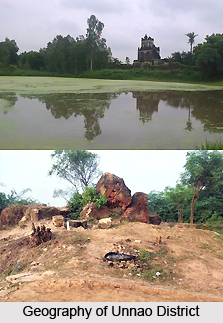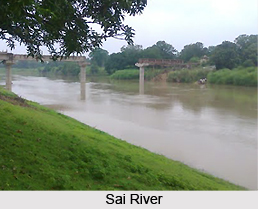 Unnao District is roughly a parallelogram in shape and lies between Latitude 26 degree 8 minutes and 27 degree 2 minutes North and Longitude 80 degree 3 minutes and 81 degree 3 minutes East. It is bounded on the North by Hardoi District, on the East by Lucknow District, on the South by Rae Bareli District and on the West by the Ganga which separates it from districts of Kanpur and Fatehpur. The district covers an area of 4589 Sq. Km. Ganga and Sai the chief rivers of the district have played an important role in fashioning the topology of the district which may be divided into two main parts - the Lowlands and the Upland.
Unnao District is roughly a parallelogram in shape and lies between Latitude 26 degree 8 minutes and 27 degree 2 minutes North and Longitude 80 degree 3 minutes and 81 degree 3 minutes East. It is bounded on the North by Hardoi District, on the East by Lucknow District, on the South by Rae Bareli District and on the West by the Ganga which separates it from districts of Kanpur and Fatehpur. The district covers an area of 4589 Sq. Km. Ganga and Sai the chief rivers of the district have played an important role in fashioning the topology of the district which may be divided into two main parts - the Lowlands and the Upland.
Lowlands of Unnao District
These tracts comprising about 23.7 percent of the total area of the district lie along the Ganga in the west and along the Sai in the extreme north and east. The lowland of the Ganga also known as the tarai or khadar lies between the main channel of the river, and its old high bank. It varies in width from a km to about 10 km getting wide wherever the Ganga meets its tributaries, for instance, in the north-west and in Pariyar Pargana. The narrowest section of the tract lies in the pargana Unnao near the railway bridge over the Ganga. The Lowland is liable to frequent floods and is thinly populated. A considerable area of the tract is overgrown with grass and babul trees. The characteristic soil is stiff clay except where sand has been deposited by fluvial action. The lowland produces usually a precarious Kharif harvest and good Rabi crops in a succession of dry years but it is disappointing in a wet cycle. Along the immediate bank of the river, there is a narrow strip of alluvial land, constantly subject to inundations. The Ganga lowlands comprise 19 percent of the total area of the Unnao district. The lowland of Sai is similar though smaller in extent. It contains mostly a stiff and moist soil liable to get waterlogged in wet years and produces reh which considerably reduces its fertility.
Upland of Unnao District
Extending from the old high bank of Ganga to the Sai valley, the upland comprises about 76 percent of the area of the district. The course of the high bank, though irregular, is well defined. On top of the high bank, there is a belt of high soil, with a width of 1.5 km to 7 km. In the upland, the surface is gently undulating, the water table low, and the irrigation facilities scanty. Another belt of similar light soil is met with along the banks of the Sai. The soil occasionally rises to bhur and, in parganas Sikandarpur and Faterpur Chaurasi, there are substantial sandy bluffs projecting into the Tarai. Further inland, the tract is mainly of fertile stiff loam broken by large usar wastes and shallow rice depressions. At places, ridges of sandy soil cause large depressions of clay. The deeper of these depressions form permanent lakes and tanks. The depths and sizes of these lakes and tanks increase as one proceeds from north to south. The streams running through the tract are comparatively unimportant, with the exception of the Basha and Loni streams. The country on either side of the former, which springs in the bhur tract in the North West of pargana Jhalotar-Ajgain and runs, like a stream, through parganas Gorinda-Parsandan, Purwa and Mauranwan and then leaves the district for Rae Bareli, is characterised by frequent outcrops of bhur. It provides a cheap and easy means of irrigation and excellent crops of rice are, in many places, grown in its bed. The Loni is shallow at its source, but during the rains, it flows in a wide bed in which excellent crops of transplanted paddy are grown.
 River Systems of Unnao District
River Systems of Unnao District
The Ganga and the Sai are the main rivers of the district, the former making its western and southern boundaries and the latter, for the greater part of its course, forming its northern and eastern boundaries. Among the other mainstreams of the district are Kalyani, the Tanai, the Loni and the Morahi (Naurahi), all tributaries of the Ganga. These rivers generally run dry during the hot weather, but hold water during the greater part of the year and are utilized for irrigation.
The only great river of the district is the Ganga River which first touches the district near the village of Purwa Gahir, in Pargana Bangarmau and flows south-eastward, seperating this district from districts Kanpur and Fatehpur. Generally it flows from north-west to the south-east, but it makes several sharp bends such as those near Umriya Bhagwantpur, and Rustampur in tehsil Safipur, Rautapur in tehsil Unnao and Ratua Khera and Duli Khera in tehsil Purwa. The Ganga receives the Morahi near Baksar where it flows close to its old high bank. It leaves the district at a short distance from Baksar.
The river is not, however, put to use either as a waterway or as a source of irrigation. There are several ferries for pedestrians and pilgrims but none of them approaches what may be termed a trade route. The river cannot, as a rule is utilised for irrigation owing to the height of the bank but certain of its small drainage channels or sotas, which run island for a considerable distance in some parganas, are sometimes used to irrigate crops grown in low-lying alluvial lands. Otherwise, cultivated lands lie at great distances and cannot be irrigated from the river whose water would, in order to irrigate these lands, have to be passed through the sands on the sides of the river, and in the process be greatly washed, if not altogether absorbed. The main channel of the river is subject to constant variation and the cultivation in its immediate neighbourhood is, therefore of a shifting kind.
It appears from its old high bank that the river has a general tendency to shift its course to the west. In the days of Akbar, the river skirted the village of Ghatampur but has since then so altered its course that it now runs about 8 km to the south-west of this village.
There is unusually large number of swamps and lakes of great size and value, particularly in the southern and eastern parts of the district. The larger lakes, which hold water all the year round, are the Kundra Samundar near Jhalotar, the lake near Nawalganj, the wide expanse of water near Kantha and the long chain of lakes in pargana Mauranwan. In Tehsil Safipur, the more important tanks are those at Mawai-Bhari and Kursat and the Harial Tal near Mustafabad. In Tehsil Hasanganj, besides the Kundra Samundar at Mawai, there are the Kulli Bani and Jalesar tanks near Ajgain and the chain of lakes called Basaha, which it seems, partakes of certain characteristics of a stream also, travelling a distance of 96 Kms in the district and eventually leaving it for district Rae Bareli where it is reckoned as a tributary of the river Sai. In the western part of the Tehsil are the Katgari Lake near Asiwan and the stretches of water at Amarpur, Sambha, Sheothana, Marenda and Asakhera, but in its northern and eastern parts, there are only small and very shallow tanks which dry up when rainfall is deficient. In Tehsil Unnao there are no important lakes, but a number of very shallow depressions, which get filled up with water during the rains and yield excellent crop of rice.
In Tehsil Purwa there are many lakes, situated in a well defined belt stretching along the whole length of the tehsil. The main among them are the lakes at Kantha, Bhadain, Unchagaon, Qila, Akhori, Miri, Zorawarganj and Sarwan, the Barhna tank near Sagauli, the Mohan and Sukrar lakes near Mauranwan, and several others like the Bharda Lake, skirting district Rae Bareli. Besides these, there are the tanks at Sahrawan, the Bhundi tank at Gulariha, and the Kumbha tank at Bhagwantnagar. The lakes at Kantha, Sagauli, and Barela contain water all the year round, while the others generally provide irrigation for the Rabi crops only, drying up in the years of drought. These lakes and tanks abound in fish, and singhara (water chestnut) is very extensively grown in them.
Geologically the district forms part of the vast Indo-Gangetic alluvial tract, of which the origin is attributed to a sag in the earth`s crust, formed, in the upper Eocene times, between the northwardly drifting Gondwanaland and the rising Himalayan belt, and gradually filled in by sediments so as to constitute a level plane with a very gentle seaward slope. The alluvium formation of the district, comprising sand, silt & clay with occasional gravel, is of the early quaternary to sub-recent age. The older alluvium called bhangar, forms slightly elevated terraces usually above the flood levels. It is rather dark in colour generally rich in concretions and nodules of impure calcium carbonate, locally known as kankar. The newer alluvium, called khandar, forming the lowlands between the Ganga and Bhangar, is light colored; poor in calcarious contain and composed of lenticular beds of sand, gravel and clays. The economic minerals found in the district are kankar, reh and sand.



















